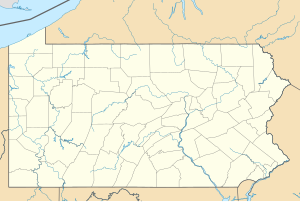Walnut Lane Bridge
Coordinates: 40 ° 1 '56 " N , 75 ° 11' 58" W.
| Walnut Lane Bridge | ||
|---|---|---|
| use | Road bridge | |
| Crossing of | Wissahickon Creek | |
| place | Philadelphia , Pennsylvania , USA | |
| construction | Concrete arch bridge | |
| Longest span | 71 m | |
| Clear height | 45 m | |
| start of building | 1906 | |
| completion | 1908 | |
| location | ||
|
|
||
The Walnut Lane Bridge is a concrete arch bridge in Philadelphia , Pennsylvania , USA . It leads Walnut Lane over the deeply cut Wissahickon Creek and thus connects the districts of Germantown and Roxborough in the borough of Northwest Philadelphia.
description
The road bridge has a lane in both directions, a cycle path separated by markings and a wide sidewalk that is bordered to the outside by a balustrade .
The 178 m long bridge crosses the valley cut with a large double arch with a span of 71 m at a height of 45 m above the watercourse. The arrow height of the double arch is 21.42 m (70 ft 3 in). On both sides of these double arches, four 6 m wide saving arches are erected to support the bridge plate. The double arches are framed on both sides by strong pillars and a total of 5 double arches over the slopes of the valley, each with a span of 16 m. The bridge slab is a total of 17 m wide and was originally divided into a 12.20 m wide carriageway for four lanes and 2.4 m wide sidewalks.
The Walnut Lane Bridge is a true copy of the Adolphe Bridge designed by Paul Séjourné in Luxembourg , apart from the slightly changed dimensions and the fact that the Adolphe Bridge is a stone arch bridge with a reinforced concrete slab, while the Walnut Lane Bridge is a concrete arch bridge. The actual bridge construction of the Walnut Lane Bridge consists of unreinforced concrete without steel inserts, reinforced concrete was used only for the bridge slab with two parallel flat hollow boxes and the cantilevered walkways . It should be noted that under concrete time stamped concrete was understood that from gravel with a largely random grain sizes existed and it was still a long way to today's concrete of broken aggregates whose grain sizes based on a well-defined grading curve are mixed.
Like the Adolphe Bridge, the Walnut Lane Bridge does not have a huge arch that would have required enormous and expensive falsework , but two parallel narrow arches that were built one after the other so that only a narrow falsework was required. However, Paul Séjourné's ideas were not adopted to support the falsework on the sides of the fighters in order to save further material and to stabilize them with wire ropes , rather a conventional falsework was built on the valley floor.
history
On July 13, 1905, the Philadelphia City Council decided to build a viaduct to connect the districts of Germantown and Roxborough, whose residents had to drive long detours to bypass Wissahickon Creek. The Philadelphia Department of Public Works, the city's own building administration headed by George S. Webster and Henry H. Quimby, was commissioned with the planning. On July 5, 1906, the construction of the bridge, d. H. first started with the construction of the falsework. The otherwise rapidly progressing construction was overshadowed on December 27, 1907 by a serious accident with one dead and nine injured when the falsework collapsed, the dismantling of which had just started. The bridge, which was completed except for the access roads, was opened to pedestrian traffic in October 1908 and ceremoniously opened on December 16, 1908 after the rest of the work had been completed.
At the time of its opening, the Walnut Lane Bridge was the largest concrete arch bridge in the world; its span of 71 m exceeded that of the Grünwalder Isar Bridge completed in 1904 by one meter. But the Rocky River Bridge (also Detroit Avenue Bridge ) with a span of 85 m over the Rocky River in Cuyahoga County , Ohio was already under construction and was completed in 1910. In 1911 the Ponte del Risorgimento in Rome followed , a reinforced concrete bridge with a flat segment arch and a span of 100 m.
During a review in 2010, various age-related deficiencies were discovered, which will be remedied from 2013 as part of a major renovation.
The Walnut Lane Bridge has been listed on the National Register of Historic Places (NRHP) as a cultural monument since 1988 .
Other bridges
The Walnut Lane Bridge is easily confused with the Walnut Street Bridge , an iron girder bridge completed in 1900 over the Schuylkill River in Philadelphia, with the nearby, similar looking Wissahickon Memorial Bridge , a concrete arch bridge completed in 1931 or with the Walnut Lane Memorial Bridge , the first prestressed concrete girder bridge of the USA, which has been running along Walnut Lane over a branch of Wissahickon Creek since 1951.
Web links
Individual evidence
- ↑ Plan sketch - side view on walnutlanebridge.org
- ↑ Sketches of the Walnut Lane Bridge on walnutlanebridge.org
- ↑ About Walnut Lane Bridge at walnutlanebridge.org
- ↑ plan sketch of falsework on walnutlanebridge.org
- ↑ History on walnutlanebridge.org
- ↑ NRHP entry
- ↑ Photo of the Walnut Street Bridge
- ↑ Photo of the Walnut Memorial Bridge

